
Burkina Faso is a landlocked country in West Africa with an area of 274,223 km2 (105,878 sq mi), bordered by Mali to the northwest, Niger to the northeast, Benin to the southeast, Togo and Ghana to the south, and Ivory Coast to the southwest. As of 2021, the country had an estimated population of 20,321,378. Previously called Republic of Upper Volta (1958–1984), it was renamed Burkina Faso by President Thomas Sankara. Its citizens are known as Burkinabè, and its capital and largest city is Ouagadougou.
The Iron Age is the final epoch of the three historical Metal Ages, after the Copper and Bronze Ages. It has also been considered as the final Age of the three-age division starting with prehistory and progressing to protohistory. In this usage, it is preceded by the Stone Age and Bronze Age. These concepts originated for describing Iron Age Europe and the Ancient Near East, but they now include other parts of the Old World.
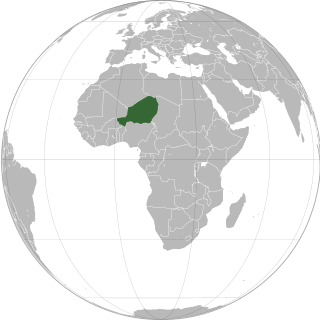
Niger or the Niger, officially the Republic of the Niger, is a landlocked country in West Africa. It is a unitary state bordered by Libya to the northeast, Chad to the east, Nigeria to the south, Benin and Burkina Faso to the southwest, Mali to the west, and Algeria to the northwest. It covers a land area of almost 1,270,000 km2 (490,000 sq mi), making it the largest landlocked country in West Africa and the second largest landlocked nation in Africa behind Chad. Over 80% of its land area lies in the Sahara. Its predominantly Muslim population of about 25 million lives mostly in clusters in the south and west of the country. The capital Niamey is located in Niger's southwest corner.
This is the history of Niger. See also the history of Africa and the history of West Africa.

The history of Burkina Faso includes the history of various kingdoms within the country, such as the Mossi kingdoms, as well as the later French colonisation of the territory and its independence as the Republic of Upper Volta in 1960.

African art describes the modern and historical paintings, sculptures, installations, and other visual culture from native or indigenous Africans and the African continent. The definition may also include the art of the African diasporas, such as: African-American, Caribbean or art in South American societies inspired by African traditions. Despite this diversity, there are unifying artistic themes present when considering the totality of the visual culture from the continent of Africa.

Sudano-Sahelian architecture refers to a range of similar indigenous architectural styles common to the African peoples of the Sahel and Sudanian grassland (geographical) regions of West Africa, south of the Sahara, but north of the fertile forest regions of the coast.
The Mandé peoples are an ethnolinguistic grouping of native African ethnic groups who speak Mande languages. Various Mandé speaking ethnic groups are found particularly in the western regions of West Africa. The Mandé languages are divided into two primary groups: East Mandé and West Mandé.

The Nok culture is a population whose material remains are named after the Ham village of Nok in southern Kaduna State of Nigeria, where their terracotta sculptures were first discovered in 1928. The Nok people and the Gajiganna people may have migrated from the Central Sahara, along with pearl millet and pottery, diverged prior to arriving in the northern region of Nigeria, and thus, settled in their respective locations in the region of Gajiganna and Nok. Nok people may have also migrated from the West African Sahel to the region of Nok. Nok culture may have emerged in 1500 BCE and continued to persist until 1 BCE.
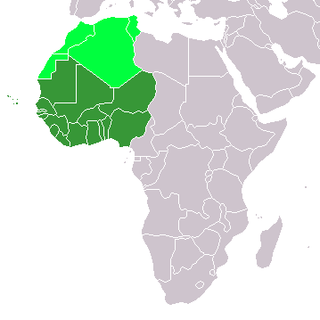
The history of West Africa has been divided into its prehistory, the Iron Age in Africa, the period of major polities flourishing, the colonial period, and finally the post-independence era, in which the current nations were formed. West Africa is west of an imagined north–south axis lying close to 10° east longitude, bordered by the Atlantic Ocean and Sahara Desert. Colonial boundaries are reflected in the modern boundaries between contemporary West African states, cutting across ethnic and cultural lines, often dividing single ethnic groups between two or more states.

Djenné-Djenno is a UNESCO World Heritage Site located in the Niger River Valley in the country of Mali. Literally translated to "ancient Djenné", it is the original site of both Djenné and Mali and is considered to be among the oldest urbanized centers and the best-known archaeology site in West Africa. This archaeological site is located about three kilometres from the modern town, and is believed to have been involved in long distance trade and possibly the domestication of African rice. The site is believed to exceed 33 hectares in area; however this is yet to be confirmed with extensive survey work. With the help of archaeological excavations mainly by Roderick and Susan McIntosh, the site is known to have been occupied from 250 BC to 900 AD. The city is believed to have been abandoned and moved where the current city is located due to the spread of Islam and the building of the Great Mosque of Djenné. Previously, it was assumed that advanced trade networks and complex societies did not exist in the region until the arrival of traders from Southwest Asia. However, sites such as Djenné-Djenno disprove this, as these traditions in West Africa flourished long before. More recently, it has been concluded that the egalitarian civilization of Djenne-Djenno was likely established by the Mande progenitors of the Bozo people, which spanned from 3rd century BCE to 13th century CE.

The history of Nigeria before 1500 has been divided into its prehistory, Iron Age, and flourishing of its kingdoms and states. Acheulean tool-using archaic humans may have dwelled throughout West Africa since at least between 780,000 BP and 126,000 BP. Middle Stone Age West Africans likely dwelled continuously in West Africa between MIS 4 and MIS 2, and Iwo Eleru people persisted at Iwo Eleru as late as 13,000 BP. West African hunter-gatherers occupied western Central Africa earlier than 32,000 BP, dwelled throughout coastal West Africa by 12,000 BP, and migrated northward between 12,000 BP and 8000 BP as far as Mali, Burkina Faso, and Mauritania. The Dufuna canoe, a dugout canoe found in northern Nigeria has been dated to around 6556-6388 BCE and 6164-6005 BCE, making it the oldest known boat in Africa and the second oldest worldwide.

Iron metallurgy in Africa developed within Africa; though initially assumed to be of external origin, this assumption has been rendered untenable; archaeological evidence has increasingly supported an indigenous origin. Some recent studies date the inception of iron metallurgy in Africa between 3000 BCE and 2500 BCE. Archaeometallurgical scientific knowledge and technological development originated in numerous centers of Africa; the centers of origin were located in West Africa, Central Africa, and East Africa; consequently, as these origin centers are located within inner Africa, these archaeometallurgical developments are thus native African technologies.
The archeological site of Bura is located in the Tillabéry Region, of the Tera Department, in southwest Niger. The Bura archeological site has given its name to the area's first-millennium Bura culture.
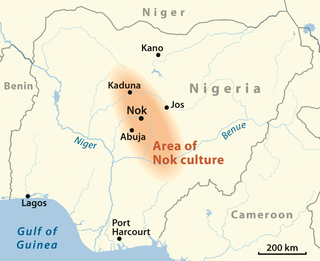
Taruga is an archeological site in Nigeria famous for the artifacts of the Nok culture that have been discovered there, some dating to 600 BC, and for evidence of very early iron working. The site is 60 km southeast of Abuja, in the Middle Belt.

The Bronze Head from Ife, or Ife Head, is one of eighteen copper alloy sculptures that were unearthed in 1938 at Ife in Nigeria, the religious and former royal centre of the Yoruba people. It is believed to represent a king. It was probably made in the fourteenth-fifteenth century C.E. The realism and sophisticated craftsmanship of the objects challenged the offensive and patronising Western conceptions of African art. The naturalistic features of the Ife heads are unique and the stylistic similarities of these works "suggest that they were made by an individual artist or in a single workshop."
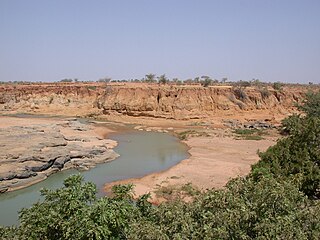
Ounjougou is the name of a lieu-dit found in the middle of an important complex of archaeological sites in the Upper Yamé Valley on the Bandiagara Plateau, in Dogon Country, Mali. The Ounjougou archaeological complex consists of over a hundred sites. The analysis of many layers rich in archaeological and botanical remains has enabled establishment of a major chronological, cultural and environmental sequence crucial to understand settlement patterns in the Inland Niger Delta and West Africa. Ounjougou has yielded the earliest pottery found in Africa, and is believed to be one of the earliest regions in which the independent development of pottery occurred.
Kissi is a Burkinabe archaeological site located in the Oudalan Province of Burkina Faso, near the lake Mare de Kissi and near the borders of Mali, Niger, and the Niger River. Occupied during the Iron Age, Kissi provides evidence for Iron Age textiles, beads, and mortuary practices. The site also has unique ceramic and settlement sequences to it, with clusters of mounds located throughout the site. Radiocarbon dating dates the specific occupation of the site from 1000 BC to 1300 AD.
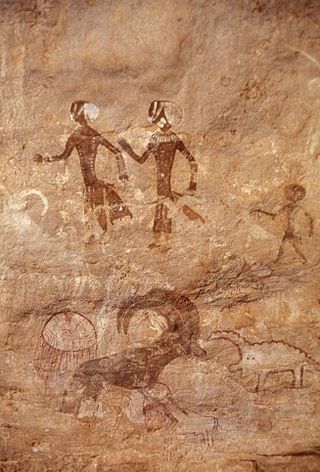
The prehistory of West Africa spans from the earliest human presence in the region until the emergence of the Iron Age in West Africa. West African populations were considerably mobile and interacted with one another throughout the population history of West Africa. Acheulean tool-using archaic humans may have dwelled throughout West Africa since at least between 780,000 BP and 126,000 BP. During the Pleistocene, Middle Stone Age peoples, who dwelled throughout West Africa between MIS 4 and MIS 2, were gradually replaced by incoming Late Stone Age peoples, who migrated into West Africa as an increase in humid conditions resulted in the subsequent expansion of the West African forest. West African hunter-gatherers occupied western Central Africa earlier than 32,000 BP, dwelled throughout coastal West Africa by 12,000 BP, and migrated northward between 12,000 BP and 8000 BP as far as Mali, Burkina Faso, and Mauritania.

The population history of West Africa is composed of West African populations that were considerably mobile and interacted with one another throughout the history of West Africa. Acheulean tool-using archaic humans may have dwelled throughout West Africa since at least between 780,000 BP and 126,000 BP. During the Pleistocene, Middle Stone Age peoples, who dwelled throughout West Africa between MIS 4 and MIS 2, were gradually replaced by incoming Late Stone Age peoples, who migrated into West Africa as an increase in humid conditions resulted in the subsequent expansion of the West African forest. West African hunter-gatherers occupied western Central Africa earlier than 32,000 BP, dwelled throughout coastal West Africa by 12,000 BP, and migrated northward between 12,000 BP and 8000 BP as far as Mali, Burkina Faso, and Mauritania.













